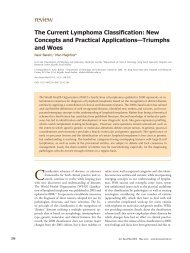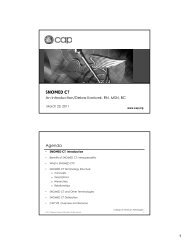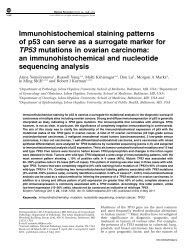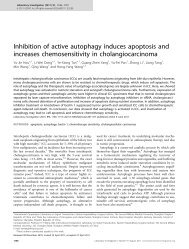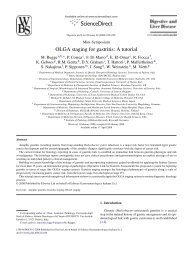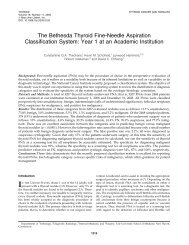SUBTYPES OF OVARIAN CARCINOMA 429Fig. 8Ovarian clear cell <strong>carcinoma</strong> with (A) papillary, (B) tubulocystic and (C) solid growth patterns and (D) hobnail cells.and most probably represent the extreme end <strong>of</strong> the spectrum <strong>of</strong>high grade serous <strong>carcinoma</strong> since undifferentiated areas arenot uncommonly seen in the latter. With a seemingly undifferentiated<strong>ovarian</strong> <strong>carcinoma</strong>, further sampling may reveal areasmore diagnostic <strong>of</strong> high grade serous <strong>carcinoma</strong>, such as vaguepapillary formations, slit-like spaces or psammoma bodies(Fig. 9). Global gene expression studies support the hypothesisthat most undifferentiated <strong>ovarian</strong> <strong>carcinoma</strong>s are related tohigh grade serous <strong>carcinoma</strong>. 3 WT1 staining also supports thissince many, but not all, undifferentiated <strong>ovarian</strong> <strong>carcinoma</strong>sexhibit nuclear staining with this marker which is commonlyexpressed in <strong>ovarian</strong> serous <strong>carcinoma</strong>. 1,3 A smaller number <strong>of</strong>undifferentiated <strong>ovarian</strong> <strong>carcinoma</strong>s may represent dedifferentiationwithin a low grade endometrioid adeno<strong>carcinoma</strong>;the concept <strong>of</strong> dedifferentiation within uterine and <strong>ovarian</strong>Fig. 9 Largely undifferentiated <strong>ovarian</strong> <strong>carcinoma</strong> (top) where foci with apapillary architecture are present in keeping with high grade serous <strong>carcinoma</strong>(bottom).endometrioid adeno<strong>carcinoma</strong>s, especially the former, has beenhighlighted in recent years. 91MIXED CARCINOMASAccording to the WHO, a mixed <strong>carcinoma</strong> should only bediagnosed when the minor component makes up at least 10% <strong>of</strong>the neoplasm. 6 However, all morphological <strong>subtypes</strong> within an<strong>ovarian</strong> <strong>carcinoma</strong> should be documented and the percentageslisted, even if the minor component accounts for less than 10%.True mixed <strong>carcinoma</strong>s <strong>of</strong> the ovary (unlike in the uterus) arerelatively uncommon, although they do occur. 1–4 A combination<strong>of</strong> endometrioid and clear cell <strong>carcinoma</strong> occasionallyoccurs since both tumour types commonly arise in endometriosis.Neoplasms which are diagnosed as mixed serous andendometrioid or mixed serous and clear cell <strong>carcinoma</strong> mostlyrepresent high grade serous <strong>carcinoma</strong>s with areas which mimicendometrioid or clear cell <strong>carcinoma</strong>; the combination <strong>of</strong>serous and endometrioid or serous and clear cell <strong>carcinoma</strong>is uncommon. This is discussed further in the next section. Thecombinations <strong>of</strong> serous and undifferentiated or endometrioidand undifferentiated <strong>carcinoma</strong> have already been discussed.The former should be reported as a high grade serous <strong>carcinoma</strong>with a comment that undifferentiated areas are present and thatthis is in keeping with the spectrum <strong>of</strong> high grade serous<strong>carcinoma</strong>.PROBLEMATIC AREAS IN TYPING OF OVARIANCARCINOMASThere are problems with regard to typing some poorly differentiated<strong>ovarian</strong> <strong>carcinoma</strong>s. The situation has improved overthe past few years and a recent study has shown that when usingmodern diagnostic criteria, excellent interobserver agreementcan be achieved amongst specialist gynaecological and generalpathologists in the typing <strong>of</strong> <strong>ovarian</strong> <strong>carcinoma</strong>s. 92 In fact, theCopyright © Royal College <strong>of</strong> pathologists <strong>of</strong> Australasia. Unauthorized reproduction <strong>of</strong> this article is prohibited.
430 MCCLUGGAGE <strong>Pathology</strong> (2011), 43(5), Augustsituation is much better with <strong>ovarian</strong> than uterine <strong>carcinoma</strong>swhere considerable problems still exist in the categorisation <strong>of</strong>high grade <strong>carcinoma</strong>s. Many <strong>of</strong> the difficulties in classification<strong>of</strong> <strong>ovarian</strong> <strong>carcinoma</strong>s relate to the categories <strong>of</strong> high gradeserous, high grade endometrioid and undifferentiated <strong>carcinoma</strong>in which there is morphological overlap. Another problematicarea is the categorisation <strong>of</strong> clear cell areas within an <strong>ovarian</strong><strong>carcinoma</strong>, specifically whether these represent a clear cell<strong>carcinoma</strong> or component <strong>of</strong> clear cell <strong>carcinoma</strong> or clear cellswithin a serous, endometrioid or undifferentiated <strong>carcinoma</strong>.Previously some pathologists tended to diagnose manypoorly differentiated <strong>ovarian</strong> <strong>carcinoma</strong>s as serous in type,while others classified them as endometrioid or mixed serousand endometrioid. The prevailing view, and my personalopinion, is that the vast majority represent high grade serous<strong>carcinoma</strong>s. In this distinction, WT1 immunohistochemicalstaining may be <strong>of</strong> value. 93–96 Most (80–90%) primary <strong>ovarian</strong>(as well as primary peritoneal and tubal) serous <strong>carcinoma</strong>sexhibit diffuse nuclear positivity with WT1 while most endometrioidadeno<strong>carcinoma</strong>s are negative or at the most focallypositive. 93–96 In problematic cases, WT1 staining is recommendedas an adjunct to help distinguish between a high gradeserous and a high grade endometrioid adeno<strong>carcinoma</strong>. Asdiscussed, most undifferentiated <strong>ovarian</strong> <strong>carcinoma</strong>s representthe extreme end <strong>of</strong> the spectrum <strong>of</strong> high grade serous <strong>carcinoma</strong>and WT1 staining may be useful in this regard. There is now awidely held view that most high grade serous and undifferentiated<strong>carcinoma</strong>s, and what some report as high gradeendometrioid <strong>carcinoma</strong>s, represent variants <strong>of</strong> high gradeserous <strong>carcinoma</strong>; this is supported by global gene expressionstudies which cannot distinguish these at a molecular level. 3Characteristically in <strong>ovarian</strong> clear cell <strong>carcinoma</strong>, an admixture<strong>of</strong> growth patterns is present, as discussed previously. 85Most clear cell <strong>carcinoma</strong>s are diagnosed without difficulty butthere is a tendency to overdiagnose clear cell <strong>carcinoma</strong> or aclear cell <strong>carcinoma</strong> component due to the presence <strong>of</strong> clearcells within serous (Fig. 10) and to a lesser extent endometrioidadeno<strong>carcinoma</strong>s. The presence <strong>of</strong> areas <strong>of</strong> more typical serousor endometrioid adeno<strong>carcinoma</strong> are useful pointers in diagnosis(as discussed, sometimes a combination <strong>of</strong> clear cell andendometrioid <strong>carcinoma</strong> occurs) and it is stressed that themere presence <strong>of</strong> clear cells does not constitute a clear cell<strong>carcinoma</strong>. WT1, ER and p53 are usually negative in <strong>ovarian</strong>clear cell <strong>carcinoma</strong>; as discussed, most high grade serous<strong>carcinoma</strong>s are positive with these markers while most endometrioid<strong>carcinoma</strong>s are ER positive. Recently, hepatocytenuclear factor 1 beta has been shown to be a promising nuclearmarker <strong>of</strong> <strong>ovarian</strong> (and uterine) clear cell <strong>carcinoma</strong>s, 97,98although further studies are needed to more fully evaluatethe full range <strong>of</strong> immunoreactivity with this marker.CONCEPT OF TYPE I AND TYPE II OVARIANCARCINOMAGiven the major recent advances in our knowledge regardingthe pathogenesis, natural history and behaviour <strong>of</strong> the major<strong>subtypes</strong> <strong>of</strong> <strong>ovarian</strong> <strong>carcinoma</strong>s, we can now think <strong>of</strong> a broaddualistic pathway <strong>of</strong> <strong>ovarian</strong> epithelial carcinogenesis; similarto the uterus, the terms type I and type II <strong>ovarian</strong> <strong>carcinoma</strong>shave been proposed. 2 This does not imply that the terms type Iand type II <strong>carcinoma</strong> should replace the specific histological<strong>subtypes</strong> but, like the dualistic pathway relating to the pathogenesis<strong>of</strong> uterine <strong>carcinoma</strong>s, this terminology is concernedwith broad mechanisms <strong>of</strong> tumour development. Type Itumours are considered to arise via a well defined adenoma<strong>carcinoma</strong>sequence from a benign precursor lesion, such as aborderline tumour or endometriosis, and to evolve in a stepwisefashion. They are associated with a variety <strong>of</strong> molecular events,as discussed earlier. Type I tumours are, in general, slowgrowing and indolent neoplasms and include low grade serous,endometrioid, mucinous and clear cell <strong>carcinoma</strong> and malignantBrenner tumour. There are obvious parallels with type Iendometrial cancers which are also, in general, indolent andarise from a well defined precursor, atypical hyperplasia. Incontrast, type II <strong>ovarian</strong> <strong>carcinoma</strong>s are high grade clinicallyaggressive neoplasms. Most represent high grade serous <strong>carcinoma</strong>.Carcinosarcoma (similar to the situation in the uterinecorpus, most <strong>ovarian</strong> examples represent high grade serous<strong>carcinoma</strong>s with sarcomatous elements which derive from theepithelial malignancy 99,100 ) and undifferentiated <strong>carcinoma</strong>,which are both predominantly variants <strong>of</strong> high grade serous<strong>carcinoma</strong>, are also included in this category. Type II <strong>carcinoma</strong>sare <strong>of</strong>ten associated with TP53 mutations and there isemerging evidence that many arise from the epithelium <strong>of</strong> thedistal fallopian tube. Again there are obvious parallels with typeII endometrial cancers. In rare cases, a type I <strong>carcinoma</strong> cantransform into a type II, as discussed earlier.Address for correspondence: Pr<strong>of</strong>essor W. G. McCluggage, Department <strong>of</strong><strong>Pathology</strong>, Royal Group <strong>of</strong> Hospitals Trust, Grosvenor Road, Belfast BT126BA, Northern Ireland. E-mail: glenn.mccluggage@belfasttrust.hscni.netFig. 10 High grade serous <strong>carcinoma</strong> <strong>of</strong> ovary containing cells with clearcytoplasm resulting in potential for misdiagnosis as clear cell <strong>carcinoma</strong>.References1. McCluggage WG. My approach to and thoughts on typing <strong>of</strong> <strong>ovarian</strong><strong>carcinoma</strong>s. J Clin Pathol 2008; 61: 152–63.2. Shih IM, Kurman RJ. Ovarian tumorigenesis. A proposed model based onmorphological and molecular genetic analysis. Am J Pathol 2004; 164:1511–8.3. Gilks CB. Subclassification <strong>of</strong> <strong>ovarian</strong> surface epithelial tumors based oncorrelation <strong>of</strong> histologic and molecular pathologic data. Int J GynecolPathol 2004; 23: 200–2005.4. Soslow RA. Histologic <strong>subtypes</strong> <strong>of</strong> <strong>ovarian</strong> <strong>carcinoma</strong>: an overview. Int JGynecol Pathol 2008; 27: 161–74.5. Nomura H, Tsuda H, Susumu N, et al. Lymph node metastasis in grosslyapparent stages I and II epithelial <strong>ovarian</strong> cancer. Int J Gynecol Cancer2010; 20: 341–5.6. Tavassoli FA, Devilee P, editors. World Health Organisation Classification<strong>of</strong> Tumours. <strong>Pathology</strong> and Genetics. Tumours <strong>of</strong> the Breast and FemaleGenital Organs. Lyon: IARC Press, 2003.Copyright © Royal College <strong>of</strong> pathologists <strong>of</strong> Australasia. Unauthorized reproduction <strong>of</strong> this article is prohibited.




